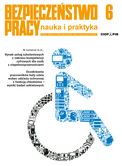Active luminous elements in the high visibility clothing and EU conformity assessment
mgr inż. Krzysztof Łężak, mgr inż. Agnieszka Greszta
The insufficient, individual visibility of employees in various work environments and road traffic participants (e.g. in the night conditions, during bad weather), is still one the main causes of road accidents involving pedestrians, and collisions between people and machines. Both in professional and non-professional activities, the use of high visibility (warning) clothing and reflective elements seems to be the only way to increase the individual visibility of a human.
A dynamically developing market of various types of non-incadescent light sources with small size, often flexible, emitting light with different colors and photometric parameters allows the application of these luminous elements to the warning clothing.
The article presents examples of electroluminescent light sources (LED diodes, El wire, El tape, El panel) and optical fibers applied in the warning clothing.
The analysis of the current detailed normative requirements and the legal status regarding the use of warning clothing with active light sources indicates that they are not sufficient to carry out the tests and EU conformity assessment of this type of protective clothing.
Women at physical work stations – limitations resulting from gender and age
dr n. med. Elżbieta Łastowiecka-Moras
Contemporary studies indicate the lack of a positive impact of high physical effort in professional work on health, especially in connection with the deficit of recreational physical activity during leisure time. Women, due to physiological conditions, are not able to perform all activities at work equally with men. This applies in particular to work related to physical effort, transport of weights and forced body position. In the case of older women, apart from the physiological differences dictated by gender, functional changes occurring in the ageing human body, which also significantly reduce the ability to perform physical work, are added.
The problem of employers disregarding hard physical labour leads to adverse effects for both them and their companies. Excessive work load and, associated with it, fatigue of employees result in inferior quality and work efficiency and the increase in sick leave due to ailments and illnesses. Therefore, it seems obvious to adapt the work station and working conditions to the needs of older women that perform physical work.
Selected methods of stress prevention among medical psychiatric and addiction treatment wards
dr Anna Łuczak, dr hab. Łukasz Baka, mgr Andrzej Najmiec
Following an earlier publication (“BP” No. 2/2018) on the causes of stress in medical staff at psychiatric and addiction treatment wards, this article presents examples of methods of stress prevention, related to emotional requirements and patients’ aggression, the principal sources of stress in this occupational group. This article also presents examples of methods aimed at promoting health.
Basic indicators of work sustainability among EU countries in the light of the European Foundation for the Improvement of Living and Working Conditions research
dr Zofia Pawłowska
According to the research of the European Foundation for the Improvement of Living and Working Conditions (Eurofound), the period of occupational activity can depend not only on the retirement system, but also on adapting work to the specific and changing needs of workers over the course of their lives. The work which fits these needs is defined as sustainable work.
The Eurofound’s studies have shown that the perceived ability to work until the age of 60 is related to factors such as self-rated health, subjective well-being, work–life balance and the perceived job security, career prospects and employability. Indicators for these factors can be also used as basic indicators for sustainability of work. In the article these indicators are presented for different age groups in Poland and the other EU countries, based on the Eurofound’s Quality of Life Survey and Working Conditions Survey results.





























